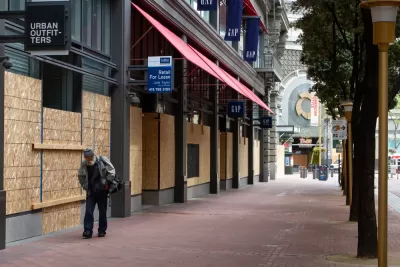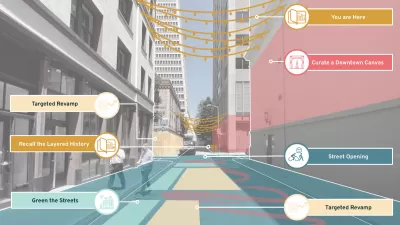A nonprofit business group released a plan to trigger the post-pandemic revitalization of Downtown San Francisco by reclaiming public space for human scale activity. But is an improved public realm sufficient to meet the challenge?

A nonprofit business group called the Downtown SF Partnership recently released the Public Realm Action Plan, created in collaboration with SITELAB urban design studio, Fehr + Peers, and John Bela, in the hopes of enticing people back to Downtown San Francisco with a less car-centric approach to the public realm.
According to a paywalled article by Noah Arroyo for the San Francisco Chronicle, the Public Realm Action Plan (PRAP) provides a development template for a part of city drastically affected by the Covid-19 pandemic in need of a comeback, with office vacancies staying stubbornly high as many tech industry companies shift to part-time and full-time remote work and residents decamp for more suburban climes. The PRAP would “entice office workers, tourists and others back to the area by revamping the landscape — closing streets to car traffic, fostering frequent outdoor events and green space, and otherwise making the area more attractive,” writes Arroyo.
As explained on its website, the PRAP Plan focuses on six action areas, comprising 43 blocks across Downtown San Francisco’s Financial District and Jackson Square Historic District.
As noted by Arroyo, the city has promised to release a downtown revitalization plan of its ow, but so far, “few specifics have emerged beyond $8 million in Mayor London Breed’s recent budget proposal for overall downtown revitalization.” The PRAP was created without a formal partnership with city leadership.
For an initial critical assessment of the PRAP, see a paywalled column by San Francisco Chronicle Urban Design Critic John King expressing skepticism about the potential of the PRAP to trigger the revitalization sought by Downtown San Francisco stakeholders.
“If you want a handy guide to the small-scale interventions that are in vogue these days for urban America — from parklets to pop-ups to cultural programming,” the PRAP is a useful document, writes King. “If you also want a document that offers a realistic blueprint for bringing the city’s Financial District back to life, keep looking.”
King offers plenty to credit the effort behind the PRAP, but the document can’t overcome a fundamental challenge facing Downtown San Francisco (and urban commercial cores in many other cities around the country): “What frames negative perceptions of the Financial District right now are empty storefronts and mostly vacant high-rises, not the lack of shady trees or lunchtime concerts.”
Planetizen picked up the news about the launch of the PRAP process in November 2021.
FULL STORY: Is this the future of downtown San Francisco? [paywall]

Maui's Vacation Rental Debate Turns Ugly
Verbal attacks, misinformation campaigns and fistfights plague a high-stakes debate to convert thousands of vacation rentals into long-term housing.

Planetizen Federal Action Tracker
A weekly monitor of how Trump’s orders and actions are impacting planners and planning in America.

Chicago’s Ghost Rails
Just beneath the surface of the modern city lie the remnants of its expansive early 20th-century streetcar system.

Bend, Oregon Zoning Reforms Prioritize Small-Scale Housing
The city altered its zoning code to allow multi-family housing and eliminated parking mandates citywide.

Amtrak Cutting Jobs, Funding to High-Speed Rail
The agency plans to cut 10 percent of its workforce and has confirmed it will not fund new high-speed rail projects.

LA Denies Basic Services to Unhoused Residents
The city has repeatedly failed to respond to requests for trash pickup at encampment sites, and eliminated a program that provided mobile showers and toilets.
Urban Design for Planners 1: Software Tools
This six-course series explores essential urban design concepts using open source software and equips planners with the tools they need to participate fully in the urban design process.
Planning for Universal Design
Learn the tools for implementing Universal Design in planning regulations.
planning NEXT
Appalachian Highlands Housing Partners
Mpact (founded as Rail~Volution)
City of Camden Redevelopment Agency
City of Astoria
City of Portland
City of Laramie





























